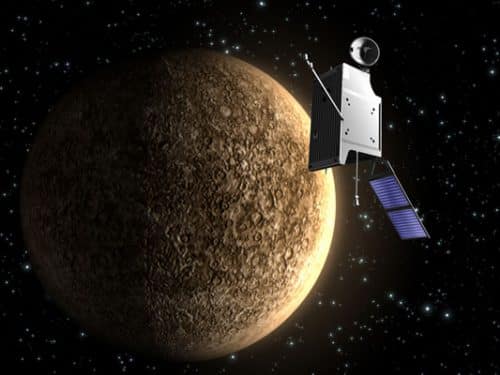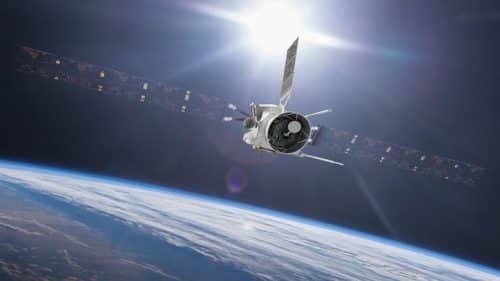Despite the relative proximity of the planet Hema to us, its location makes it difficult to launch directly to it, so the spacecraft will have to pass twice near the Earth, and twice near Venus and also near the planet Hema several times. The spacecraft is supposed to reach its destination and start exploring it at the end of 2025
Written by David Rothery, Professor of Planetary Geology, UK Open University. Translation: Avi Blizovsky
Update: The article was published before the launch, which was carried out successfully.

The European Space Agency in collaboration with the Japanese Space Agency will tonight (20/10/18, 04:45 Israel time) launch the BepiColombo spacecraft to the planet Kochav Hama from the Coureau launch base in French Guinea aboard an Ariane 5 rocket.
The spacecraft was launched 25 years after the first group of scientists suggested to the European Space Agency that a spacecraft should be launched to explore the planet Hema, and 18 years after the European Space Agency approved the project as the "cornerstone" mission. A category of excellent scientific tasks for which significant new technology is also required to be developed. The previous cornerstone missions of the European Space Agency include the Rosetta mission that studied a comet and the LISA Pathfinder space telescope.
Why the planet Hema? This is an intriguing planet. NASA's Mercury Messenger spacecraft that explored the planet Hema in 2015-2011 revealed many reasons for the scientists' enthusiasm. For example the relatively large core of the planet Mercury. We don't know why it is still molten and can create a magnetic field unlike Mars and Venus. Another mystery is the abundance of (largely unidentified) volatiles on the surface. These should not have existed in the planet formed so close to the sun and the planet Hema now.
rocket science
BepiColombo's initial orbit will be an elliptical orbit around the Sun. First in the inner part of Earth's orbit, but in early 2019 it will cross Earth's orbit and be further from the Sun for most of the year. It will then return to flyby to use Earth's gravity to accelerate towards Venus. In 2020 and a year later, the spacecraft will make similar flybys near Venus. It will then continue to perform flybys of the planet Hema in 2025-2021 and eventually in December 2025 it will slow down enough to enter orbit around the planet Hema.
The mission, which is named after Giuseppe (Baby) Colombo, who first proposed to carry out transit flights of spacecraft near planets in order to accelerate their speed, is a joint venture between the ESA and its Japanese counterpart, JAXA.
The spacecraft actually consists of two separate dashes. The one of the European Space Agency, two meters long, weighs over a ton and is a machine Mercury Planetary Orbiter, MPO. When this spacecraft reaches Mercury it will inherit the Piccolombo name. The Japanese spacecraft is smaller and weighs only a quarter of that of the European spacecraft. Last June it was decided to call it MIO, which means safe navigation in Japanese. During the journey to the planet Mercury Mio will be stored inside a sun shield while it is attached to one side of the Europan Ecliptic.
On the other side of the integrated spacecraft there is a Mercury Transfer Module, MTM, which is operated by the European Space Agency and will provide propulsion that will take the spacecraft all the way to orbit around the planet Mercury. It has 7.5 meter long wings covered with solar collectors whose function is to convert sunlight into electricity to drive the ion engine. This engine creates the acceleration by accelerating xenon gas with a positive electric charge (by separating the electrons from the atoms). This method can provide an extremely high acceleration relative to its fuel consumption than conventional chemical missiles.

The Sun's immense gravity means that it takes more energy to get the spacecraft into a stable orbit around Mercury than it takes to launch the New Horizons spacecraft to the much more distant Pluto. Because of this, the ion engine will be activated at intervals during half the flight time, mainly to slow down the spacecraft before its arrival at the planet Hema.
Unfortunately, the cruise configuration of the integrated spacecraft does not allow scientific experiments to be performed on the planets that the spacecraft passes by. The best photos we are likely to get during transit flights will be from the selfie cameras on MTM.
Upon the spacecraft's arrival at Hema in late December 2025, the transfer module will disengage, Mio will spin 15 revolutions per minute and be released into a highly elliptical orbit around Hema. The European Space Agency will operate it and use what is left of Colombo as a relay station.
The European Space Agency will then release the sun shield and the spacecraft will use its chemical engines to reach a lower, more circular orbit around Mercury. From there it will explore the surface of the planet using a variety of cameras and other tools. The data may help understand the geological history of Mercury in much better detail than the smaller, simpler Messenger. Both compasses will be equipped with magnetometers so that both Pi and Mio can simultaneously report on the state of the magnetic field in two places at the same time and thus it will be possible to learn about the magnetic field and the changes that apply to it.
For the original article on THE CONVERSATION website
More of the topic in Hayadan:
- A large valley was discovered in the planet Hema - indicating the process of the planet's contraction
- The Messenger crashed on the planet Hema
- One of two European-Japanese spacecraft to fly to Mercury in 2016 begins testing phase (News from 2014 - and of course the launch was postponed to 2018)
